The Role of Church Documents, Scripture, and Scholarship in RE
VerifiedAdded on 2020/06/06
|11
|3455
|59
Report
AI Summary
This report provides an in-depth analysis of religious education within Australian Catholic schools. It begins by outlining the nature and purpose of religious education in this context, emphasizing the importance of both intellectual and emotional learning, and the integration of faith with other subjects. The report then delves into the historical development of religious education in the 20th century, detailing the establishment of Catholic schools, the influence of religious orders, and the evolution of educational practices, including the introduction of subjects like moral science and catechism. Finally, it examines the impact of key church documents and scripture on the direction and development of religious education, highlighting the historical establishment of the Catholic Church in Australia, the role of bishops, and the evolving relationship between government and Catholic schools. The report emphasizes the importance of religious education in fostering faith, understanding, and a connection to the community.
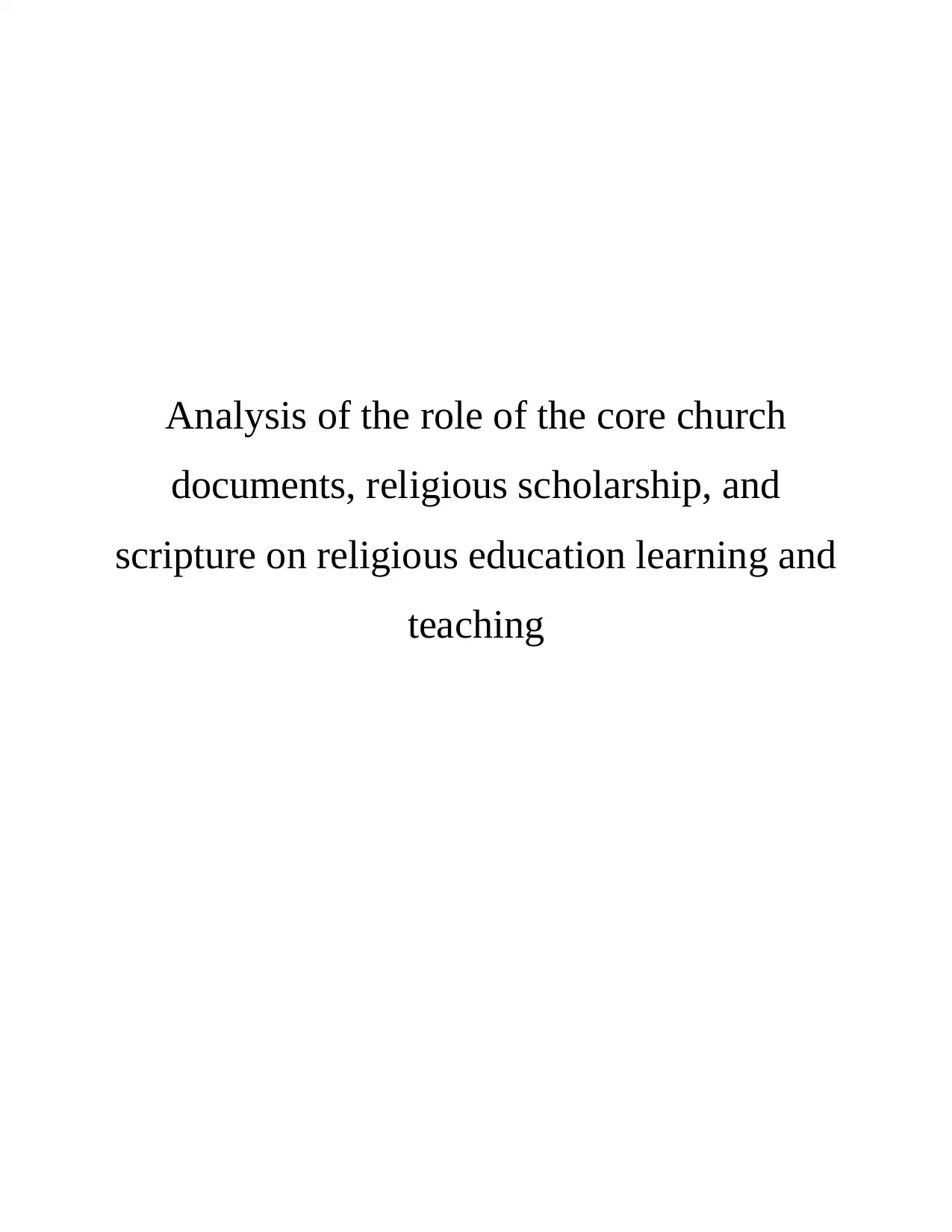
Analysis of the role of the core church
documents, religious scholarship, and
scripture on religious education learning and
teaching
documents, religious scholarship, and
scripture on religious education learning and
teaching
Paraphrase This Document
Need a fresh take? Get an instant paraphrase of this document with our AI Paraphraser
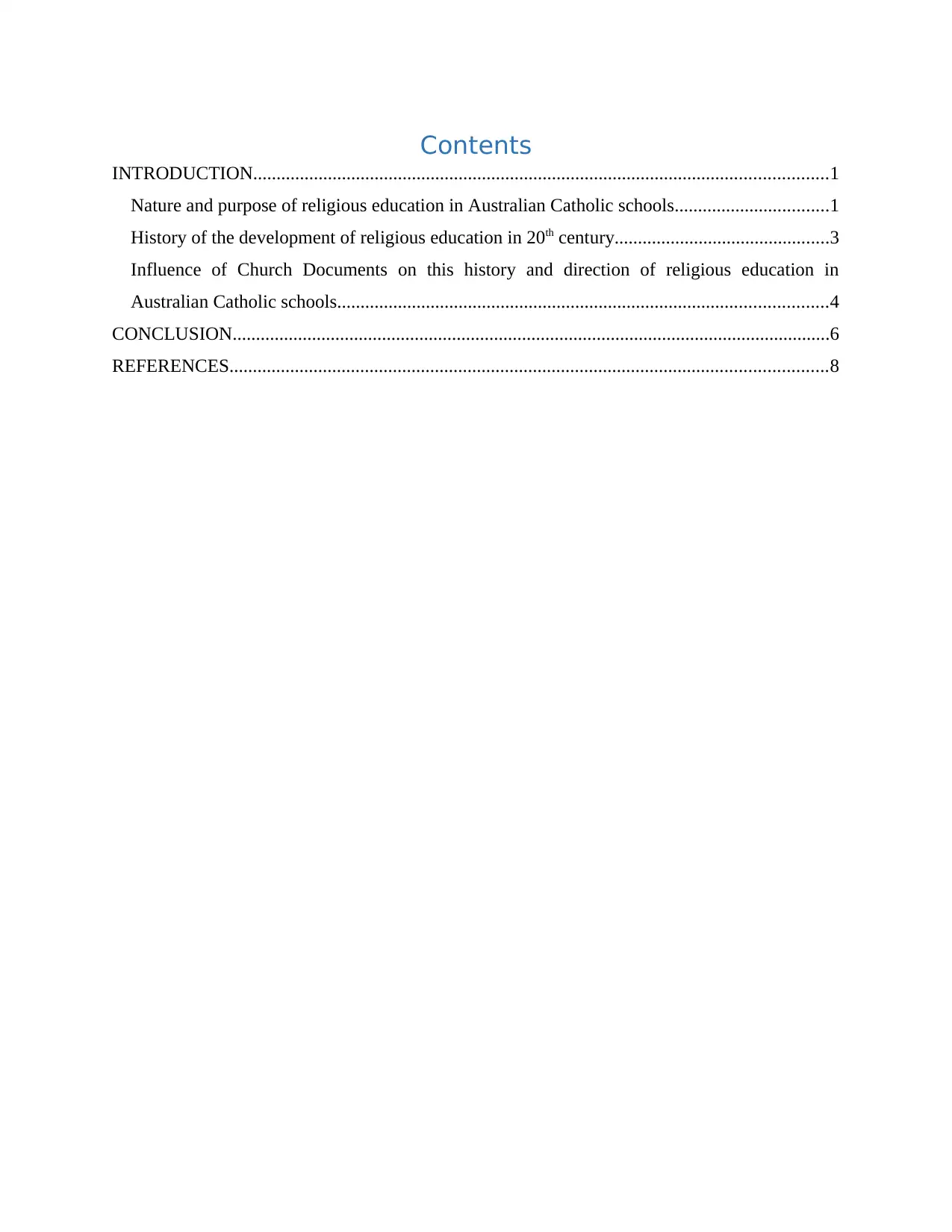
Contents
INTRODUCTION...........................................................................................................................1
Nature and purpose of religious education in Australian Catholic schools.................................1
History of the development of religious education in 20th century..............................................3
Influence of Church Documents on this history and direction of religious education in
Australian Catholic schools.........................................................................................................4
CONCLUSION................................................................................................................................6
REFERENCES................................................................................................................................8
INTRODUCTION...........................................................................................................................1
Nature and purpose of religious education in Australian Catholic schools.................................1
History of the development of religious education in 20th century..............................................3
Influence of Church Documents on this history and direction of religious education in
Australian Catholic schools.........................................................................................................4
CONCLUSION................................................................................................................................6
REFERENCES................................................................................................................................8
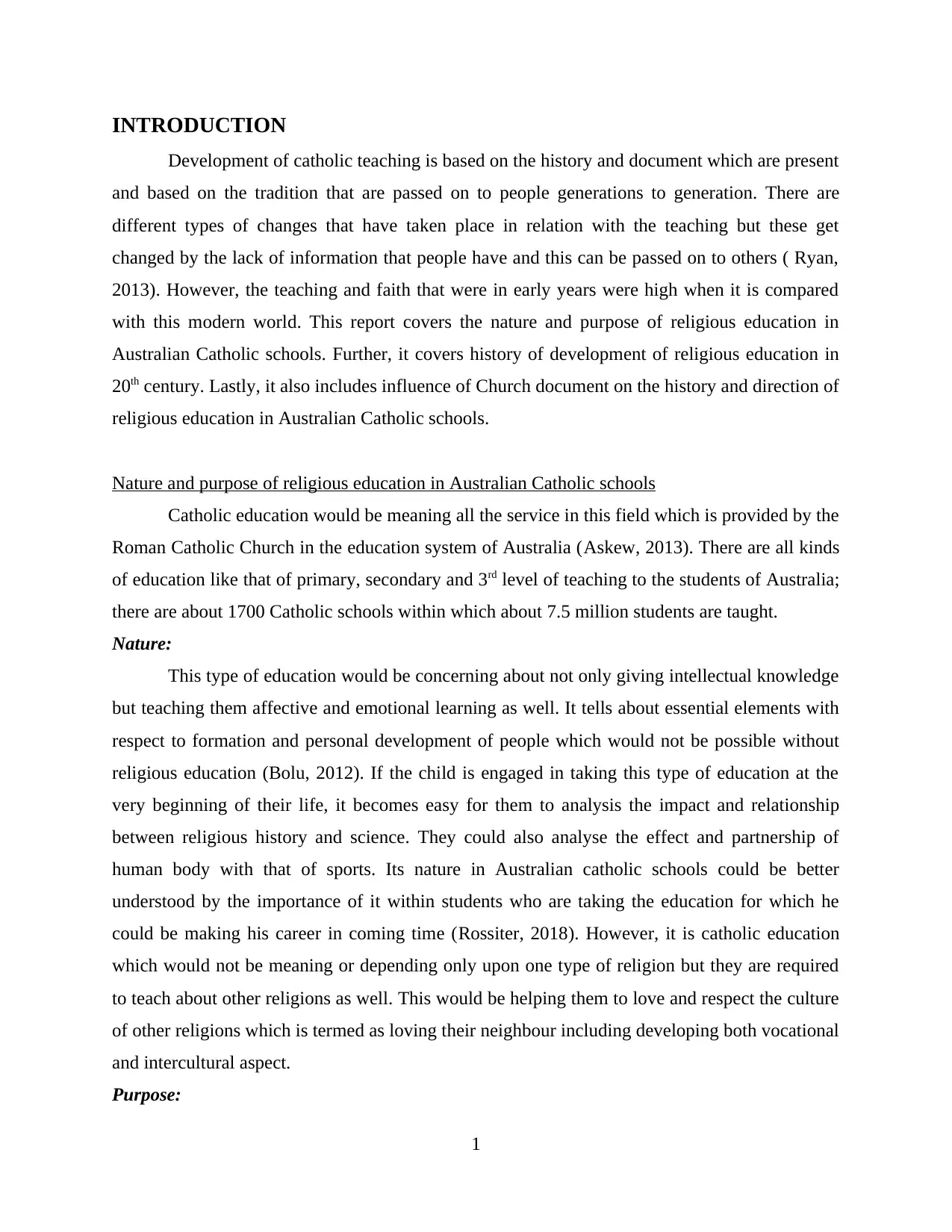
INTRODUCTION
Development of catholic teaching is based on the history and document which are present
and based on the tradition that are passed on to people generations to generation. There are
different types of changes that have taken place in relation with the teaching but these get
changed by the lack of information that people have and this can be passed on to others ( Ryan,
2013). However, the teaching and faith that were in early years were high when it is compared
with this modern world. This report covers the nature and purpose of religious education in
Australian Catholic schools. Further, it covers history of development of religious education in
20th century. Lastly, it also includes influence of Church document on the history and direction of
religious education in Australian Catholic schools.
Nature and purpose of religious education in Australian Catholic schools
Catholic education would be meaning all the service in this field which is provided by the
Roman Catholic Church in the education system of Australia (Askew, 2013). There are all kinds
of education like that of primary, secondary and 3rd level of teaching to the students of Australia;
there are about 1700 Catholic schools within which about 7.5 million students are taught.
Nature:
This type of education would be concerning about not only giving intellectual knowledge
but teaching them affective and emotional learning as well. It tells about essential elements with
respect to formation and personal development of people which would not be possible without
religious education (Bolu, 2012). If the child is engaged in taking this type of education at the
very beginning of their life, it becomes easy for them to analysis the impact and relationship
between religious history and science. They could also analyse the effect and partnership of
human body with that of sports. Its nature in Australian catholic schools could be better
understood by the importance of it within students who are taking the education for which he
could be making his career in coming time (Rossiter, 2018). However, it is catholic education
which would not be meaning or depending only upon one type of religion but they are required
to teach about other religions as well. This would be helping them to love and respect the culture
of other religions which is termed as loving their neighbour including developing both vocational
and intercultural aspect.
Purpose:
1
Development of catholic teaching is based on the history and document which are present
and based on the tradition that are passed on to people generations to generation. There are
different types of changes that have taken place in relation with the teaching but these get
changed by the lack of information that people have and this can be passed on to others ( Ryan,
2013). However, the teaching and faith that were in early years were high when it is compared
with this modern world. This report covers the nature and purpose of religious education in
Australian Catholic schools. Further, it covers history of development of religious education in
20th century. Lastly, it also includes influence of Church document on the history and direction of
religious education in Australian Catholic schools.
Nature and purpose of religious education in Australian Catholic schools
Catholic education would be meaning all the service in this field which is provided by the
Roman Catholic Church in the education system of Australia (Askew, 2013). There are all kinds
of education like that of primary, secondary and 3rd level of teaching to the students of Australia;
there are about 1700 Catholic schools within which about 7.5 million students are taught.
Nature:
This type of education would be concerning about not only giving intellectual knowledge
but teaching them affective and emotional learning as well. It tells about essential elements with
respect to formation and personal development of people which would not be possible without
religious education (Bolu, 2012). If the child is engaged in taking this type of education at the
very beginning of their life, it becomes easy for them to analysis the impact and relationship
between religious history and science. They could also analyse the effect and partnership of
human body with that of sports. Its nature in Australian catholic schools could be better
understood by the importance of it within students who are taking the education for which he
could be making his career in coming time (Rossiter, 2018). However, it is catholic education
which would not be meaning or depending only upon one type of religion but they are required
to teach about other religions as well. This would be helping them to love and respect the culture
of other religions which is termed as loving their neighbour including developing both vocational
and intercultural aspect.
Purpose:
1
⊘ This is a preview!⊘
Do you want full access?
Subscribe today to unlock all pages.

Trusted by 1+ million students worldwide
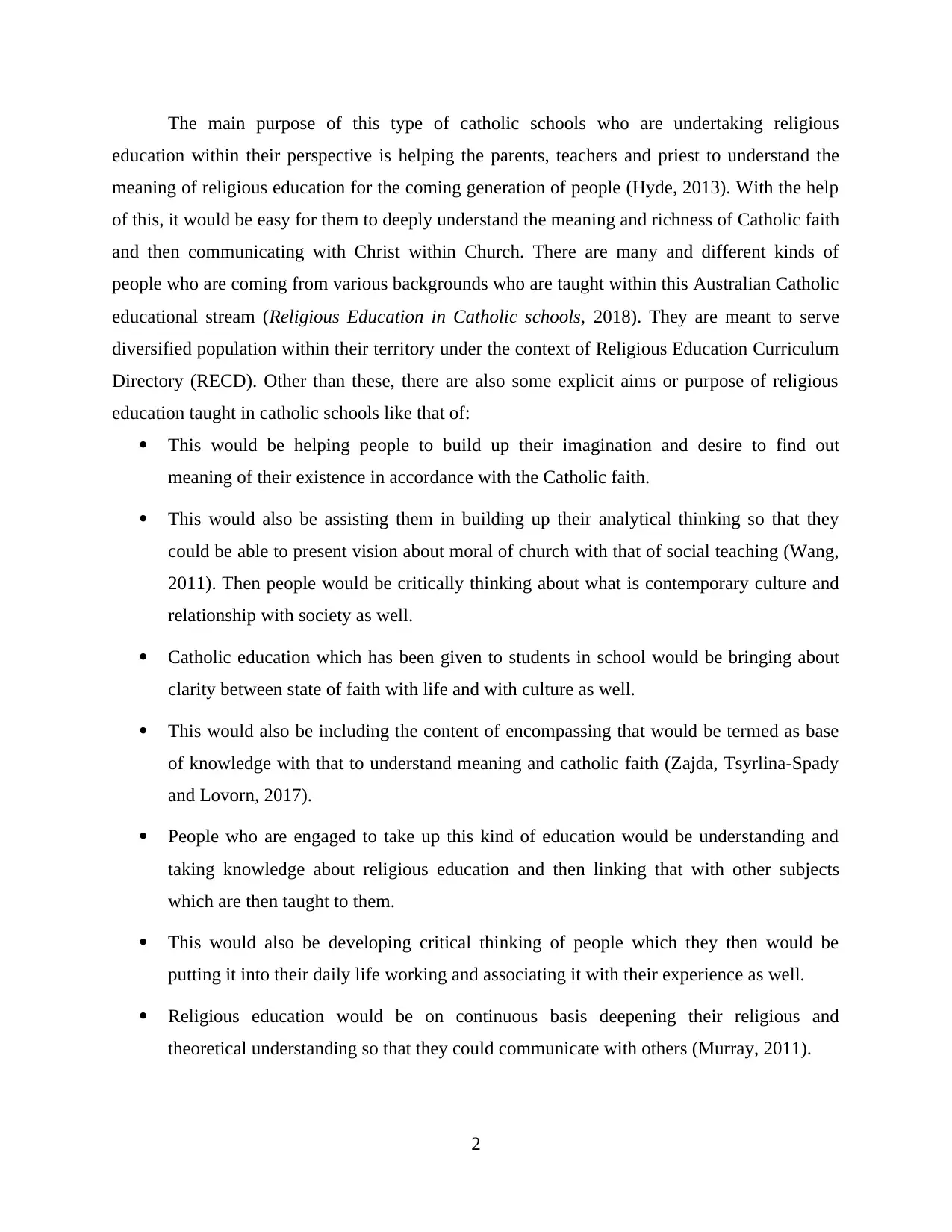
The main purpose of this type of catholic schools who are undertaking religious
education within their perspective is helping the parents, teachers and priest to understand the
meaning of religious education for the coming generation of people (Hyde, 2013). With the help
of this, it would be easy for them to deeply understand the meaning and richness of Catholic faith
and then communicating with Christ within Church. There are many and different kinds of
people who are coming from various backgrounds who are taught within this Australian Catholic
educational stream (Religious Education in Catholic schools, 2018). They are meant to serve
diversified population within their territory under the context of Religious Education Curriculum
Directory (RECD). Other than these, there are also some explicit aims or purpose of religious
education taught in catholic schools like that of:
This would be helping people to build up their imagination and desire to find out
meaning of their existence in accordance with the Catholic faith.
This would also be assisting them in building up their analytical thinking so that they
could be able to present vision about moral of church with that of social teaching (Wang,
2011). Then people would be critically thinking about what is contemporary culture and
relationship with society as well.
Catholic education which has been given to students in school would be bringing about
clarity between state of faith with life and with culture as well.
This would also be including the content of encompassing that would be termed as base
of knowledge with that to understand meaning and catholic faith (Zajda, Tsyrlina-Spady
and Lovorn, 2017).
People who are engaged to take up this kind of education would be understanding and
taking knowledge about religious education and then linking that with other subjects
which are then taught to them.
This would also be developing critical thinking of people which they then would be
putting it into their daily life working and associating it with their experience as well.
Religious education would be on continuous basis deepening their religious and
theoretical understanding so that they could communicate with others (Murray, 2011).
2
education within their perspective is helping the parents, teachers and priest to understand the
meaning of religious education for the coming generation of people (Hyde, 2013). With the help
of this, it would be easy for them to deeply understand the meaning and richness of Catholic faith
and then communicating with Christ within Church. There are many and different kinds of
people who are coming from various backgrounds who are taught within this Australian Catholic
educational stream (Religious Education in Catholic schools, 2018). They are meant to serve
diversified population within their territory under the context of Religious Education Curriculum
Directory (RECD). Other than these, there are also some explicit aims or purpose of religious
education taught in catholic schools like that of:
This would be helping people to build up their imagination and desire to find out
meaning of their existence in accordance with the Catholic faith.
This would also be assisting them in building up their analytical thinking so that they
could be able to present vision about moral of church with that of social teaching (Wang,
2011). Then people would be critically thinking about what is contemporary culture and
relationship with society as well.
Catholic education which has been given to students in school would be bringing about
clarity between state of faith with life and with culture as well.
This would also be including the content of encompassing that would be termed as base
of knowledge with that to understand meaning and catholic faith (Zajda, Tsyrlina-Spady
and Lovorn, 2017).
People who are engaged to take up this kind of education would be understanding and
taking knowledge about religious education and then linking that with other subjects
which are then taught to them.
This would also be developing critical thinking of people which they then would be
putting it into their daily life working and associating it with their experience as well.
Religious education would be on continuous basis deepening their religious and
theoretical understanding so that they could communicate with others (Murray, 2011).
2
Paraphrase This Document
Need a fresh take? Get an instant paraphrase of this document with our AI Paraphraser
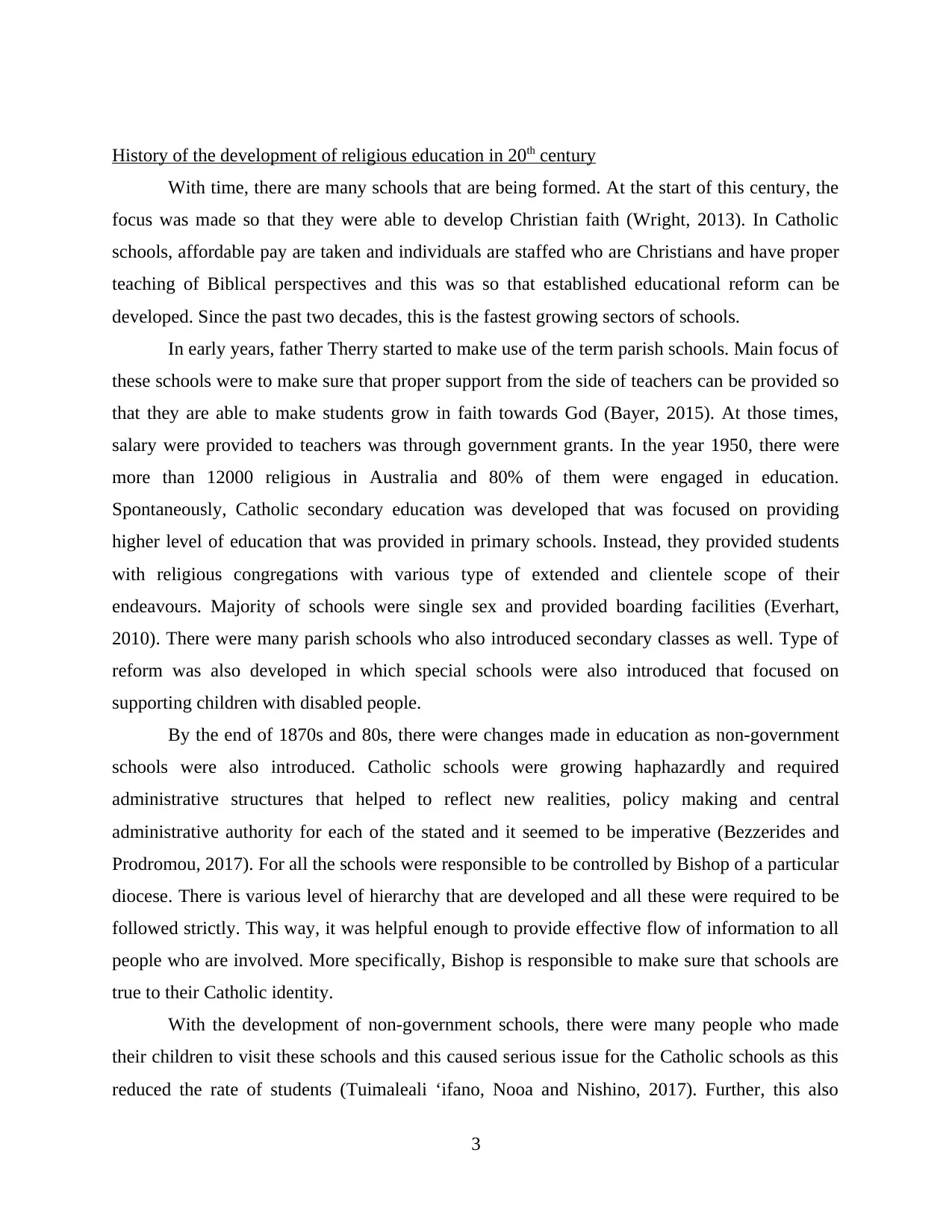
History of the development of religious education in 20th century
With time, there are many schools that are being formed. At the start of this century, the
focus was made so that they were able to develop Christian faith (Wright, 2013). In Catholic
schools, affordable pay are taken and individuals are staffed who are Christians and have proper
teaching of Biblical perspectives and this was so that established educational reform can be
developed. Since the past two decades, this is the fastest growing sectors of schools.
In early years, father Therry started to make use of the term parish schools. Main focus of
these schools were to make sure that proper support from the side of teachers can be provided so
that they are able to make students grow in faith towards God (Bayer, 2015). At those times,
salary were provided to teachers was through government grants. In the year 1950, there were
more than 12000 religious in Australia and 80% of them were engaged in education.
Spontaneously, Catholic secondary education was developed that was focused on providing
higher level of education that was provided in primary schools. Instead, they provided students
with religious congregations with various type of extended and clientele scope of their
endeavours. Majority of schools were single sex and provided boarding facilities (Everhart,
2010). There were many parish schools who also introduced secondary classes as well. Type of
reform was also developed in which special schools were also introduced that focused on
supporting children with disabled people.
By the end of 1870s and 80s, there were changes made in education as non-government
schools were also introduced. Catholic schools were growing haphazardly and required
administrative structures that helped to reflect new realities, policy making and central
administrative authority for each of the stated and it seemed to be imperative (Bezzerides and
Prodromou, 2017). For all the schools were responsible to be controlled by Bishop of a particular
diocese. There is various level of hierarchy that are developed and all these were required to be
followed strictly. This way, it was helpful enough to provide effective flow of information to all
people who are involved. More specifically, Bishop is responsible to make sure that schools are
true to their Catholic identity.
With the development of non-government schools, there were many people who made
their children to visit these schools and this caused serious issue for the Catholic schools as this
reduced the rate of students (Tuimaleali ‘ifano, Nooa and Nishino, 2017). Further, this also
3
With time, there are many schools that are being formed. At the start of this century, the
focus was made so that they were able to develop Christian faith (Wright, 2013). In Catholic
schools, affordable pay are taken and individuals are staffed who are Christians and have proper
teaching of Biblical perspectives and this was so that established educational reform can be
developed. Since the past two decades, this is the fastest growing sectors of schools.
In early years, father Therry started to make use of the term parish schools. Main focus of
these schools were to make sure that proper support from the side of teachers can be provided so
that they are able to make students grow in faith towards God (Bayer, 2015). At those times,
salary were provided to teachers was through government grants. In the year 1950, there were
more than 12000 religious in Australia and 80% of them were engaged in education.
Spontaneously, Catholic secondary education was developed that was focused on providing
higher level of education that was provided in primary schools. Instead, they provided students
with religious congregations with various type of extended and clientele scope of their
endeavours. Majority of schools were single sex and provided boarding facilities (Everhart,
2010). There were many parish schools who also introduced secondary classes as well. Type of
reform was also developed in which special schools were also introduced that focused on
supporting children with disabled people.
By the end of 1870s and 80s, there were changes made in education as non-government
schools were also introduced. Catholic schools were growing haphazardly and required
administrative structures that helped to reflect new realities, policy making and central
administrative authority for each of the stated and it seemed to be imperative (Bezzerides and
Prodromou, 2017). For all the schools were responsible to be controlled by Bishop of a particular
diocese. There is various level of hierarchy that are developed and all these were required to be
followed strictly. This way, it was helpful enough to provide effective flow of information to all
people who are involved. More specifically, Bishop is responsible to make sure that schools are
true to their Catholic identity.
With the development of non-government schools, there were many people who made
their children to visit these schools and this caused serious issue for the Catholic schools as this
reduced the rate of students (Tuimaleali ‘ifano, Nooa and Nishino, 2017). Further, this also
3
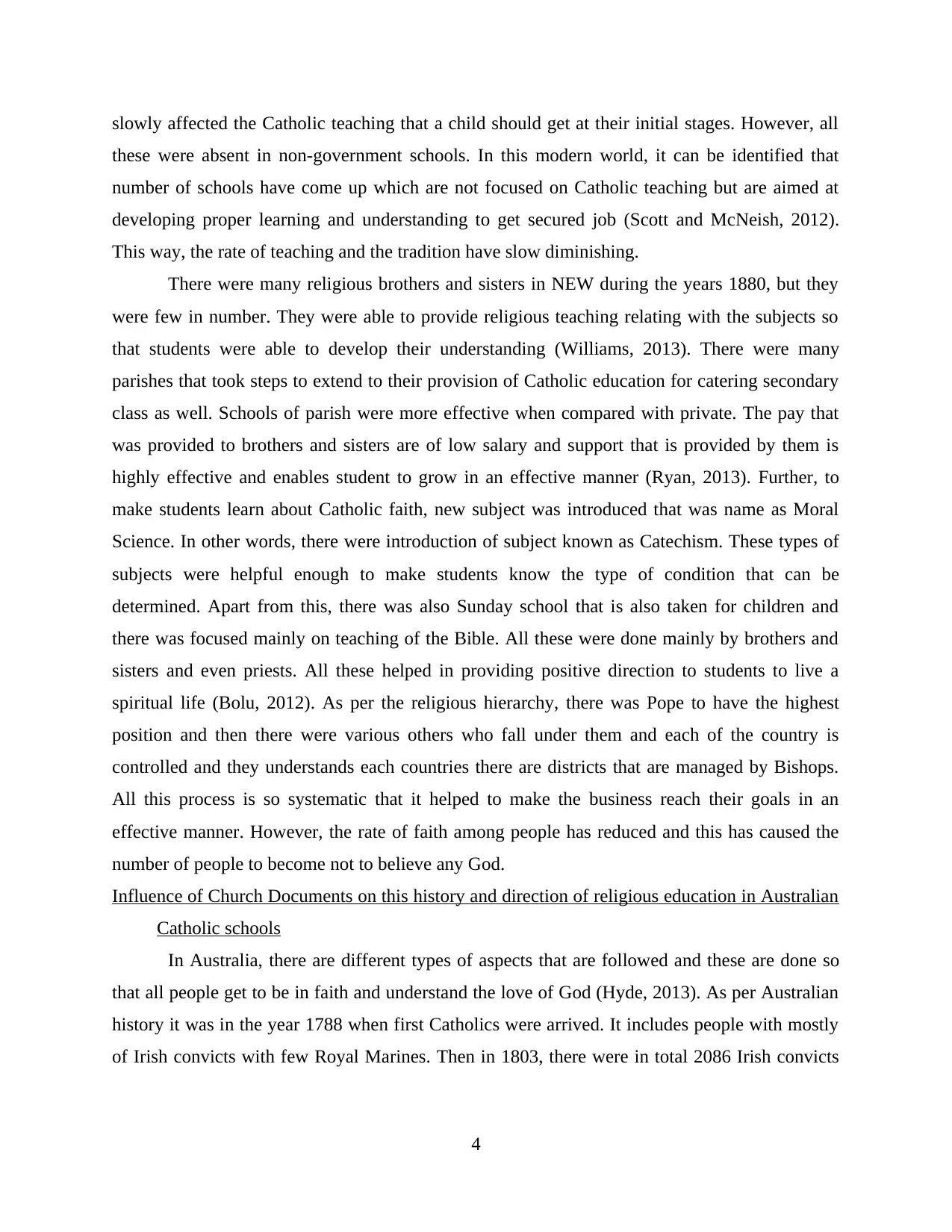
slowly affected the Catholic teaching that a child should get at their initial stages. However, all
these were absent in non-government schools. In this modern world, it can be identified that
number of schools have come up which are not focused on Catholic teaching but are aimed at
developing proper learning and understanding to get secured job (Scott and McNeish, 2012).
This way, the rate of teaching and the tradition have slow diminishing.
There were many religious brothers and sisters in NEW during the years 1880, but they
were few in number. They were able to provide religious teaching relating with the subjects so
that students were able to develop their understanding (Williams, 2013). There were many
parishes that took steps to extend to their provision of Catholic education for catering secondary
class as well. Schools of parish were more effective when compared with private. The pay that
was provided to brothers and sisters are of low salary and support that is provided by them is
highly effective and enables student to grow in an effective manner (Ryan, 2013). Further, to
make students learn about Catholic faith, new subject was introduced that was name as Moral
Science. In other words, there were introduction of subject known as Catechism. These types of
subjects were helpful enough to make students know the type of condition that can be
determined. Apart from this, there was also Sunday school that is also taken for children and
there was focused mainly on teaching of the Bible. All these were done mainly by brothers and
sisters and even priests. All these helped in providing positive direction to students to live a
spiritual life (Bolu, 2012). As per the religious hierarchy, there was Pope to have the highest
position and then there were various others who fall under them and each of the country is
controlled and they understands each countries there are districts that are managed by Bishops.
All this process is so systematic that it helped to make the business reach their goals in an
effective manner. However, the rate of faith among people has reduced and this has caused the
number of people to become not to believe any God.
Influence of Church Documents on this history and direction of religious education in Australian
Catholic schools
In Australia, there are different types of aspects that are followed and these are done so
that all people get to be in faith and understand the love of God (Hyde, 2013). As per Australian
history it was in the year 1788 when first Catholics were arrived. It includes people with mostly
of Irish convicts with few Royal Marines. Then in 1803, there were in total 2086 Irish convicts
4
these were absent in non-government schools. In this modern world, it can be identified that
number of schools have come up which are not focused on Catholic teaching but are aimed at
developing proper learning and understanding to get secured job (Scott and McNeish, 2012).
This way, the rate of teaching and the tradition have slow diminishing.
There were many religious brothers and sisters in NEW during the years 1880, but they
were few in number. They were able to provide religious teaching relating with the subjects so
that students were able to develop their understanding (Williams, 2013). There were many
parishes that took steps to extend to their provision of Catholic education for catering secondary
class as well. Schools of parish were more effective when compared with private. The pay that
was provided to brothers and sisters are of low salary and support that is provided by them is
highly effective and enables student to grow in an effective manner (Ryan, 2013). Further, to
make students learn about Catholic faith, new subject was introduced that was name as Moral
Science. In other words, there were introduction of subject known as Catechism. These types of
subjects were helpful enough to make students know the type of condition that can be
determined. Apart from this, there was also Sunday school that is also taken for children and
there was focused mainly on teaching of the Bible. All these were done mainly by brothers and
sisters and even priests. All these helped in providing positive direction to students to live a
spiritual life (Bolu, 2012). As per the religious hierarchy, there was Pope to have the highest
position and then there were various others who fall under them and each of the country is
controlled and they understands each countries there are districts that are managed by Bishops.
All this process is so systematic that it helped to make the business reach their goals in an
effective manner. However, the rate of faith among people has reduced and this has caused the
number of people to become not to believe any God.
Influence of Church Documents on this history and direction of religious education in Australian
Catholic schools
In Australia, there are different types of aspects that are followed and these are done so
that all people get to be in faith and understand the love of God (Hyde, 2013). As per Australian
history it was in the year 1788 when first Catholics were arrived. It includes people with mostly
of Irish convicts with few Royal Marines. Then in 1803, there were in total 2086 Irish convicts
4
⊘ This is a preview!⊘
Do you want full access?
Subscribe today to unlock all pages.

Trusted by 1+ million students worldwide

were transported to Botany Bay. Below given are the histories for the formation of Catholic
Church in Australia:
First priest: At the initial stages were priest but they were only for providing people with
sacraments. In accordance with the crisis that occurred in 1928, for the population of 10000, 374
were raised in lay environment and teachings of Catholic faith passed on to them even when
there were no priests (Wang, 2011). Not until 1800 first priest approved in colony as convicts.
One of them named James Dixon was provided with the permission to grant mass for Catholics
of Sydney, Parramatta and Liverpool. This practice was followed till the year 1803 to 1804 as
governor king alarmed and he withdrew Dixon’s privileges. Then in 1820, father Philip Connolly
and John Joseph got permission from Government in London. This a formal establishment of
Catholic Church in Australia was formed.
First Bishop: John Bede Polding was the catholic first bishop in Australia (Zajda,
Tsyrlina-Spady and Lovorn, 2017). All these were started as the faith of people grew in positive
direction and all were able to develop strong community in which there were systematic division
of work made.
Catholic schools: It was important for children to be ready so that they develop in
Christian faith. In the early 19th century, there two Catholic schools developed but neither of
them survived for long time (Murray, 2011). However, in the year 1820, Therry and Connolly
arrived and by the end of 1833, Ten Catholic Schools were started up in Australia. Then in
1960s, government assistance was received in which schemes were introduced to facilitate
people so that they are able to develop their learning and understanding. Between 1872 and
1893, there were Educational aid passed on by government and this was the turning point to
Catholic schools (Wright, 2013). There was no pay provided to teachers and soon, bishop
ordered to sisters and brothers from Europe so that the crisis can be taken cared off.
Growth of religious order: There were many religious orders in which people were able
to get support from these orders. In total of 115 brothers and sisters were provided with teachings
to these schools in the year 1900.
Catholics in the post war era: 1950s were considered to be the boom time for Australian
Catholics. It increased the number of Catholics population and there were many parishes
established in major cities and new suburbs plus increasing priests, brothers and sisters (Bayer,
2015). There were high level of advancement that took place for mass and other devotional
5
Church in Australia:
First priest: At the initial stages were priest but they were only for providing people with
sacraments. In accordance with the crisis that occurred in 1928, for the population of 10000, 374
were raised in lay environment and teachings of Catholic faith passed on to them even when
there were no priests (Wang, 2011). Not until 1800 first priest approved in colony as convicts.
One of them named James Dixon was provided with the permission to grant mass for Catholics
of Sydney, Parramatta and Liverpool. This practice was followed till the year 1803 to 1804 as
governor king alarmed and he withdrew Dixon’s privileges. Then in 1820, father Philip Connolly
and John Joseph got permission from Government in London. This a formal establishment of
Catholic Church in Australia was formed.
First Bishop: John Bede Polding was the catholic first bishop in Australia (Zajda,
Tsyrlina-Spady and Lovorn, 2017). All these were started as the faith of people grew in positive
direction and all were able to develop strong community in which there were systematic division
of work made.
Catholic schools: It was important for children to be ready so that they develop in
Christian faith. In the early 19th century, there two Catholic schools developed but neither of
them survived for long time (Murray, 2011). However, in the year 1820, Therry and Connolly
arrived and by the end of 1833, Ten Catholic Schools were started up in Australia. Then in
1960s, government assistance was received in which schemes were introduced to facilitate
people so that they are able to develop their learning and understanding. Between 1872 and
1893, there were Educational aid passed on by government and this was the turning point to
Catholic schools (Wright, 2013). There was no pay provided to teachers and soon, bishop
ordered to sisters and brothers from Europe so that the crisis can be taken cared off.
Growth of religious order: There were many religious orders in which people were able
to get support from these orders. In total of 115 brothers and sisters were provided with teachings
to these schools in the year 1900.
Catholics in the post war era: 1950s were considered to be the boom time for Australian
Catholics. It increased the number of Catholics population and there were many parishes
established in major cities and new suburbs plus increasing priests, brothers and sisters (Bayer,
2015). There were high level of advancement that took place for mass and other devotional
5
Paraphrase This Document
Need a fresh take? Get an instant paraphrase of this document with our AI Paraphraser
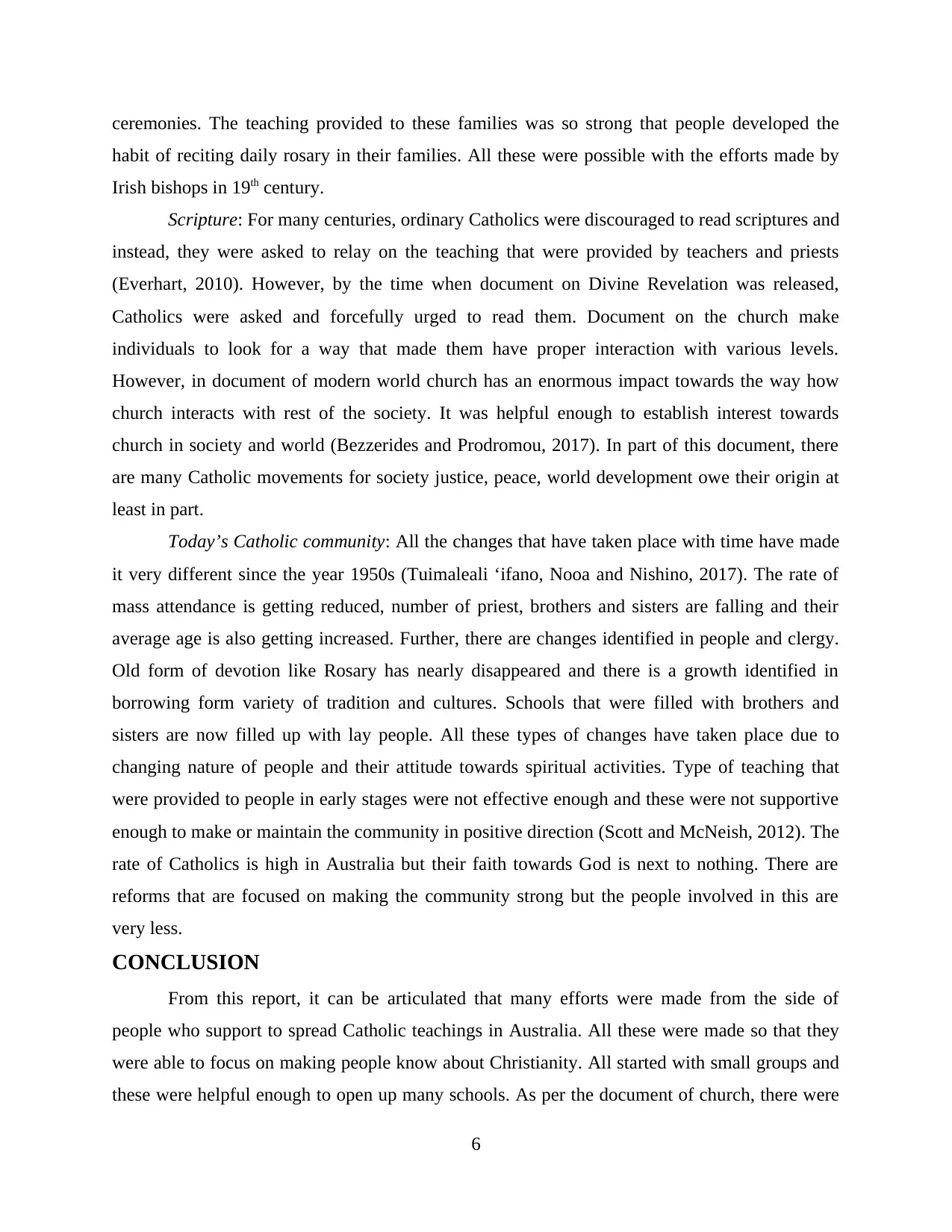
ceremonies. The teaching provided to these families was so strong that people developed the
habit of reciting daily rosary in their families. All these were possible with the efforts made by
Irish bishops in 19th century.
Scripture: For many centuries, ordinary Catholics were discouraged to read scriptures and
instead, they were asked to relay on the teaching that were provided by teachers and priests
(Everhart, 2010). However, by the time when document on Divine Revelation was released,
Catholics were asked and forcefully urged to read them. Document on the church make
individuals to look for a way that made them have proper interaction with various levels.
However, in document of modern world church has an enormous impact towards the way how
church interacts with rest of the society. It was helpful enough to establish interest towards
church in society and world (Bezzerides and Prodromou, 2017). In part of this document, there
are many Catholic movements for society justice, peace, world development owe their origin at
least in part.
Today’s Catholic community: All the changes that have taken place with time have made
it very different since the year 1950s (Tuimaleali ‘ifano, Nooa and Nishino, 2017). The rate of
mass attendance is getting reduced, number of priest, brothers and sisters are falling and their
average age is also getting increased. Further, there are changes identified in people and clergy.
Old form of devotion like Rosary has nearly disappeared and there is a growth identified in
borrowing form variety of tradition and cultures. Schools that were filled with brothers and
sisters are now filled up with lay people. All these types of changes have taken place due to
changing nature of people and their attitude towards spiritual activities. Type of teaching that
were provided to people in early stages were not effective enough and these were not supportive
enough to make or maintain the community in positive direction (Scott and McNeish, 2012). The
rate of Catholics is high in Australia but their faith towards God is next to nothing. There are
reforms that are focused on making the community strong but the people involved in this are
very less.
CONCLUSION
From this report, it can be articulated that many efforts were made from the side of
people who support to spread Catholic teachings in Australia. All these were made so that they
were able to focus on making people know about Christianity. All started with small groups and
these were helpful enough to open up many schools. As per the document of church, there were
6
habit of reciting daily rosary in their families. All these were possible with the efforts made by
Irish bishops in 19th century.
Scripture: For many centuries, ordinary Catholics were discouraged to read scriptures and
instead, they were asked to relay on the teaching that were provided by teachers and priests
(Everhart, 2010). However, by the time when document on Divine Revelation was released,
Catholics were asked and forcefully urged to read them. Document on the church make
individuals to look for a way that made them have proper interaction with various levels.
However, in document of modern world church has an enormous impact towards the way how
church interacts with rest of the society. It was helpful enough to establish interest towards
church in society and world (Bezzerides and Prodromou, 2017). In part of this document, there
are many Catholic movements for society justice, peace, world development owe their origin at
least in part.
Today’s Catholic community: All the changes that have taken place with time have made
it very different since the year 1950s (Tuimaleali ‘ifano, Nooa and Nishino, 2017). The rate of
mass attendance is getting reduced, number of priest, brothers and sisters are falling and their
average age is also getting increased. Further, there are changes identified in people and clergy.
Old form of devotion like Rosary has nearly disappeared and there is a growth identified in
borrowing form variety of tradition and cultures. Schools that were filled with brothers and
sisters are now filled up with lay people. All these types of changes have taken place due to
changing nature of people and their attitude towards spiritual activities. Type of teaching that
were provided to people in early stages were not effective enough and these were not supportive
enough to make or maintain the community in positive direction (Scott and McNeish, 2012). The
rate of Catholics is high in Australia but their faith towards God is next to nothing. There are
reforms that are focused on making the community strong but the people involved in this are
very less.
CONCLUSION
From this report, it can be articulated that many efforts were made from the side of
people who support to spread Catholic teachings in Australia. All these were made so that they
were able to focus on making people know about Christianity. All started with small groups and
these were helpful enough to open up many schools. As per the document of church, there were
6
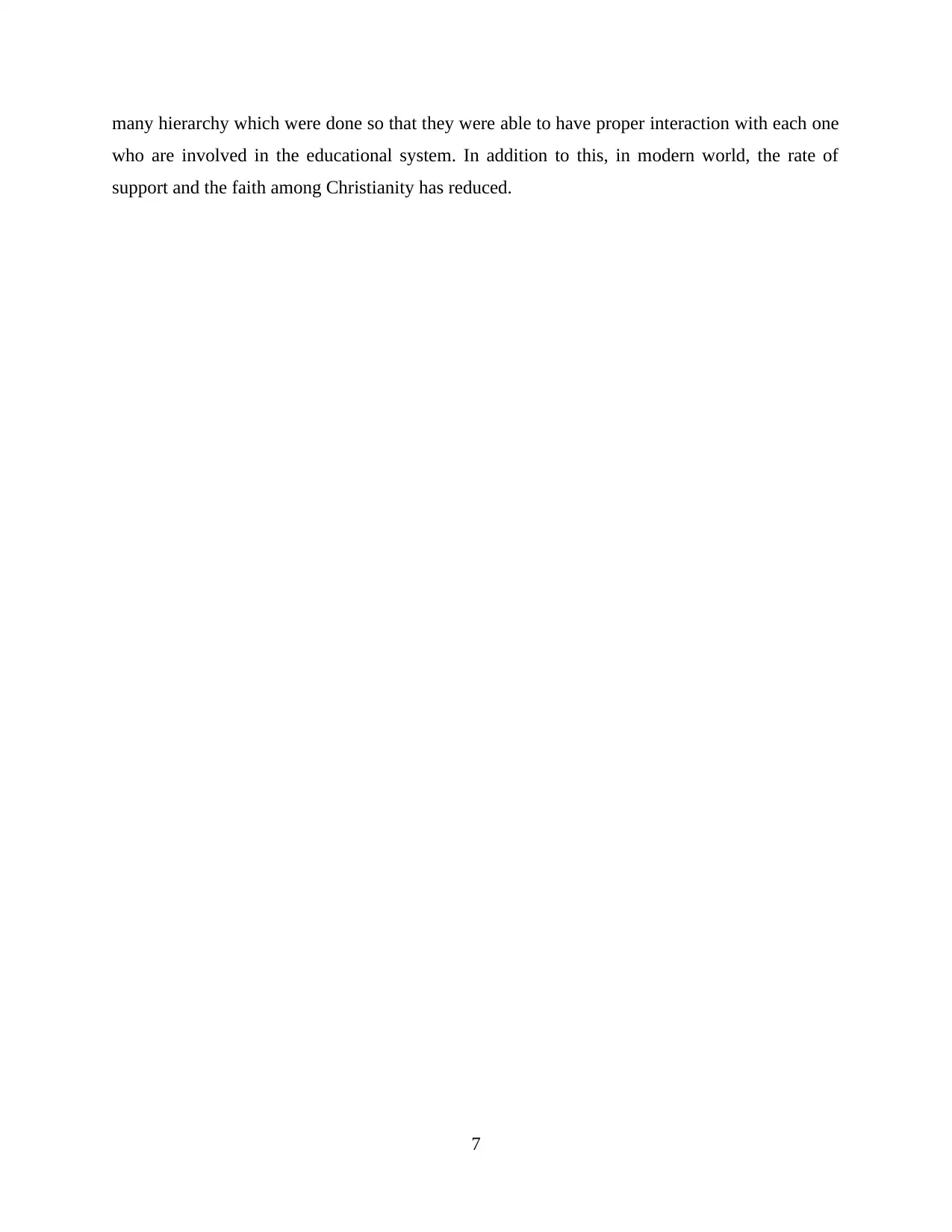
many hierarchy which were done so that they were able to have proper interaction with each one
who are involved in the educational system. In addition to this, in modern world, the rate of
support and the faith among Christianity has reduced.
7
who are involved in the educational system. In addition to this, in modern world, the rate of
support and the faith among Christianity has reduced.
7
⊘ This is a preview!⊘
Do you want full access?
Subscribe today to unlock all pages.

Trusted by 1+ million students worldwide
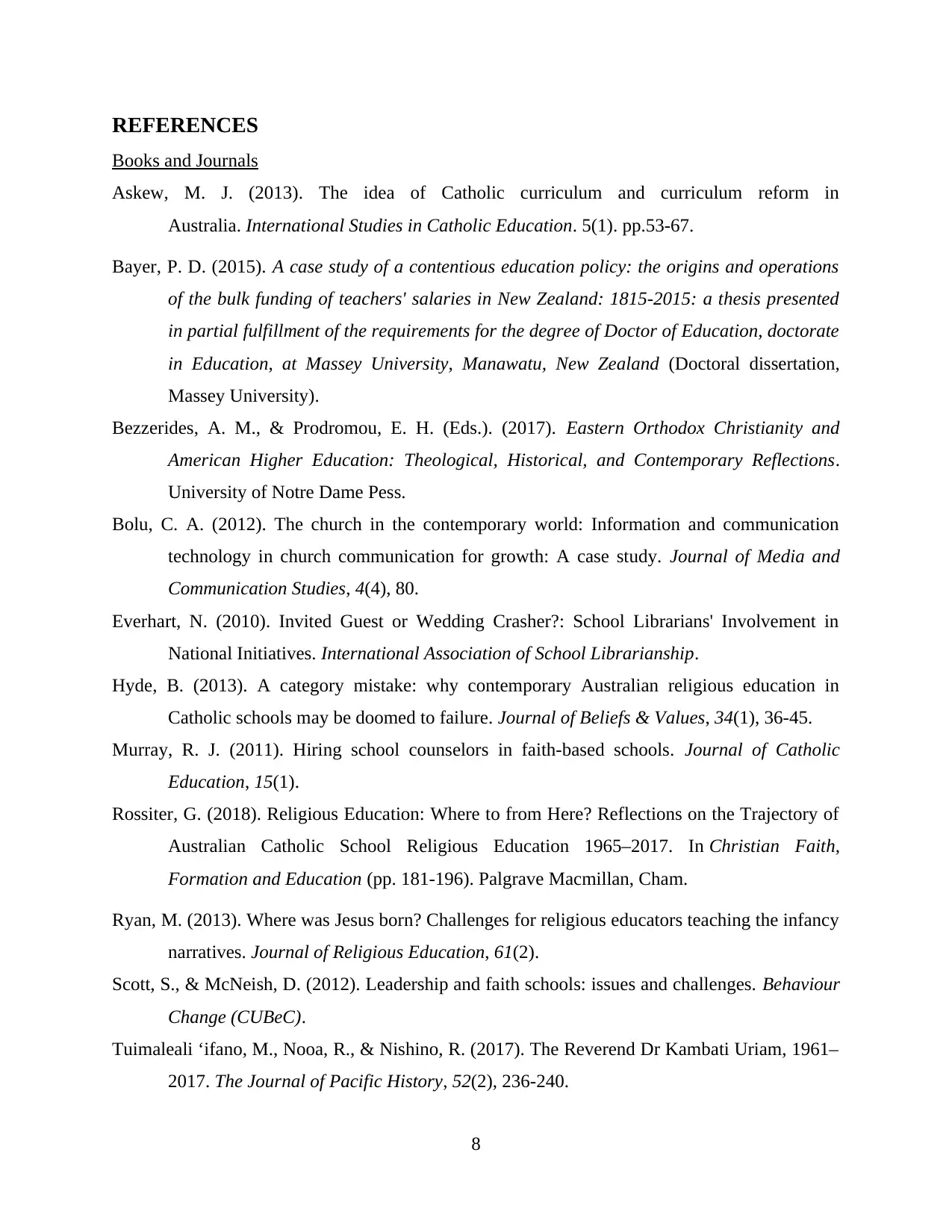
REFERENCES
Books and Journals
Askew, M. J. (2013). The idea of Catholic curriculum and curriculum reform in
Australia. International Studies in Catholic Education. 5(1). pp.53-67.
Bayer, P. D. (2015). A case study of a contentious education policy: the origins and operations
of the bulk funding of teachers' salaries in New Zealand: 1815-2015: a thesis presented
in partial fulfillment of the requirements for the degree of Doctor of Education, doctorate
in Education, at Massey University, Manawatu, New Zealand (Doctoral dissertation,
Massey University).
Bezzerides, A. M., & Prodromou, E. H. (Eds.). (2017). Eastern Orthodox Christianity and
American Higher Education: Theological, Historical, and Contemporary Reflections.
University of Notre Dame Pess.
Bolu, C. A. (2012). The church in the contemporary world: Information and communication
technology in church communication for growth: A case study. Journal of Media and
Communication Studies, 4(4), 80.
Everhart, N. (2010). Invited Guest or Wedding Crasher?: School Librarians' Involvement in
National Initiatives. International Association of School Librarianship.
Hyde, B. (2013). A category mistake: why contemporary Australian religious education in
Catholic schools may be doomed to failure. Journal of Beliefs & Values, 34(1), 36-45.
Murray, R. J. (2011). Hiring school counselors in faith-based schools. Journal of Catholic
Education, 15(1).
Rossiter, G. (2018). Religious Education: Where to from Here? Reflections on the Trajectory of
Australian Catholic School Religious Education 1965–2017. In Christian Faith,
Formation and Education (pp. 181-196). Palgrave Macmillan, Cham.
Ryan, M. (2013). Where was Jesus born? Challenges for religious educators teaching the infancy
narratives. Journal of Religious Education, 61(2).
Scott, S., & McNeish, D. (2012). Leadership and faith schools: issues and challenges. Behaviour
Change (CUBeC).
Tuimaleali ‘ifano, M., Nooa, R., & Nishino, R. (2017). The Reverend Dr Kambati Uriam, 1961–
2017. The Journal of Pacific History, 52(2), 236-240.
8
Books and Journals
Askew, M. J. (2013). The idea of Catholic curriculum and curriculum reform in
Australia. International Studies in Catholic Education. 5(1). pp.53-67.
Bayer, P. D. (2015). A case study of a contentious education policy: the origins and operations
of the bulk funding of teachers' salaries in New Zealand: 1815-2015: a thesis presented
in partial fulfillment of the requirements for the degree of Doctor of Education, doctorate
in Education, at Massey University, Manawatu, New Zealand (Doctoral dissertation,
Massey University).
Bezzerides, A. M., & Prodromou, E. H. (Eds.). (2017). Eastern Orthodox Christianity and
American Higher Education: Theological, Historical, and Contemporary Reflections.
University of Notre Dame Pess.
Bolu, C. A. (2012). The church in the contemporary world: Information and communication
technology in church communication for growth: A case study. Journal of Media and
Communication Studies, 4(4), 80.
Everhart, N. (2010). Invited Guest or Wedding Crasher?: School Librarians' Involvement in
National Initiatives. International Association of School Librarianship.
Hyde, B. (2013). A category mistake: why contemporary Australian religious education in
Catholic schools may be doomed to failure. Journal of Beliefs & Values, 34(1), 36-45.
Murray, R. J. (2011). Hiring school counselors in faith-based schools. Journal of Catholic
Education, 15(1).
Rossiter, G. (2018). Religious Education: Where to from Here? Reflections on the Trajectory of
Australian Catholic School Religious Education 1965–2017. In Christian Faith,
Formation and Education (pp. 181-196). Palgrave Macmillan, Cham.
Ryan, M. (2013). Where was Jesus born? Challenges for religious educators teaching the infancy
narratives. Journal of Religious Education, 61(2).
Scott, S., & McNeish, D. (2012). Leadership and faith schools: issues and challenges. Behaviour
Change (CUBeC).
Tuimaleali ‘ifano, M., Nooa, R., & Nishino, R. (2017). The Reverend Dr Kambati Uriam, 1961–
2017. The Journal of Pacific History, 52(2), 236-240.
8
Paraphrase This Document
Need a fresh take? Get an instant paraphrase of this document with our AI Paraphraser
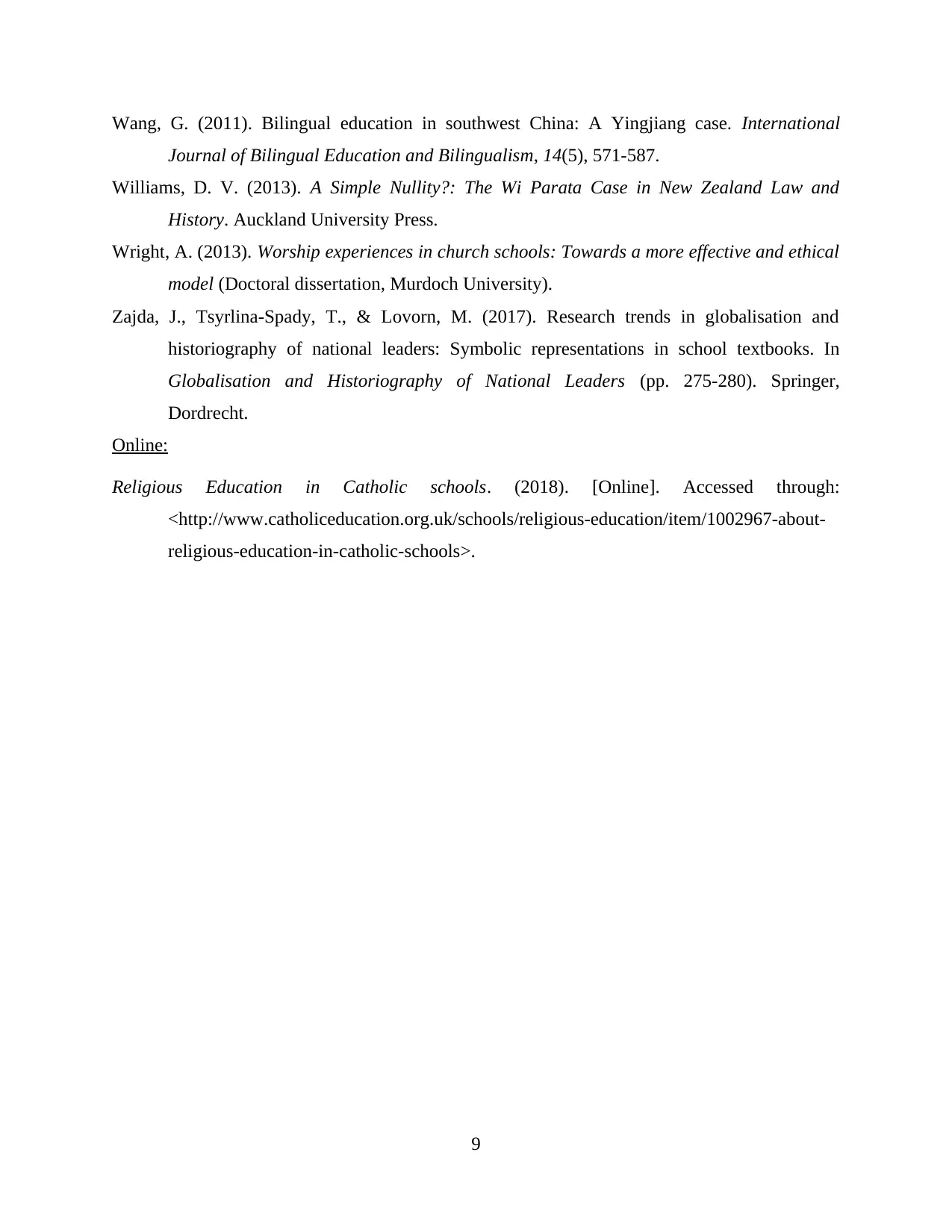
Wang, G. (2011). Bilingual education in southwest China: A Yingjiang case. International
Journal of Bilingual Education and Bilingualism, 14(5), 571-587.
Williams, D. V. (2013). A Simple Nullity?: The Wi Parata Case in New Zealand Law and
History. Auckland University Press.
Wright, A. (2013). Worship experiences in church schools: Towards a more effective and ethical
model (Doctoral dissertation, Murdoch University).
Zajda, J., Tsyrlina-Spady, T., & Lovorn, M. (2017). Research trends in globalisation and
historiography of national leaders: Symbolic representations in school textbooks. In
Globalisation and Historiography of National Leaders (pp. 275-280). Springer,
Dordrecht.
Online:
Religious Education in Catholic schools. (2018). [Online]. Accessed through:
<http://www.catholiceducation.org.uk/schools/religious-education/item/1002967-about-
religious-education-in-catholic-schools>.
9
Journal of Bilingual Education and Bilingualism, 14(5), 571-587.
Williams, D. V. (2013). A Simple Nullity?: The Wi Parata Case in New Zealand Law and
History. Auckland University Press.
Wright, A. (2013). Worship experiences in church schools: Towards a more effective and ethical
model (Doctoral dissertation, Murdoch University).
Zajda, J., Tsyrlina-Spady, T., & Lovorn, M. (2017). Research trends in globalisation and
historiography of national leaders: Symbolic representations in school textbooks. In
Globalisation and Historiography of National Leaders (pp. 275-280). Springer,
Dordrecht.
Online:
Religious Education in Catholic schools. (2018). [Online]. Accessed through:
<http://www.catholiceducation.org.uk/schools/religious-education/item/1002967-about-
religious-education-in-catholic-schools>.
9
1 out of 11
Related Documents
Your All-in-One AI-Powered Toolkit for Academic Success.
+13062052269
info@desklib.com
Available 24*7 on WhatsApp / Email
![[object Object]](/_next/static/media/star-bottom.7253800d.svg)
Unlock your academic potential
Copyright © 2020–2025 A2Z Services. All Rights Reserved. Developed and managed by ZUCOL.





